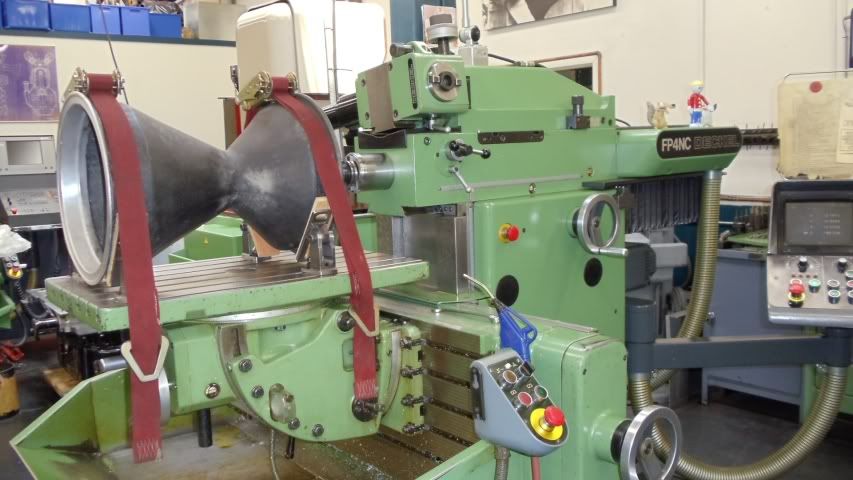Here is the question Richard reffered to:
I am rebuilding an FP3NC tool room milling machine. As a point of reference this machine is in my home shop. Main vertical casting of the machine which carries the "Z" axis has box ways.
Sliding on the box ways is a vertical slide (sort of kike a conventional BP knee) It carries the ways for the table ("X" axis).
The "X" axis is a "T" slotted table ,but mounted vertically , that is to say the face of the table is parallel with the "Z" axis.
Here is the general arrangement, with the machine shown running using the horizontal spindle.....
OK now for the problem/question:
I am working on the vertical slide ways where the "table" ("X") fits up.
This photo shows the vertical slide sitting on the main machine vertical casting box ways. The base has been removed and the casting laid down for fitting.
The area in question is the Turcite surface laying horizontal in the photo. Its the surface with the circular oil feed grooving in its face.
When the machine is assembled, this Turcite will be vertical. Its role is to support the bottom face of the "X" table from twisting in toward the machine. It counteracts
the weight of the table and work and provides a way for the "X" axis to move against.
Also seen is the tapered dovetail above the Turcite that provides the gib adjustment.
Another angle of the Turcite. Here you can also see the scraped iron way at 90* to the Turcite...This way supports the bottom surface of the "X" slide and takes the weight of the table and work, and is directly
opposite the tapered dovetail gib....
Here is the problem......
There is an area at the lower edge of one of the oil holding grooves where the Turcite has come off. In the assembled machine this gap will be facing down and will cause the oil in the groove to be able to
leak out...my fear is that this will rob the slide of proper lube.
Additional info:
The "X" axis ways and their mating surfaces on the vertical slide have already been re scraped. Done by a local machine rebuilder who i have used before and who's work is of good quality.
The piece of Turcite came out after i got the parts back form the scraper...so this is not an oversight on his part.
Point is that the remaining Turcite surface blues in fine with the "X" axis ways.
Question is should i attempt to jsut spot repair the missing area with additional Turcite (or something else?)
Or should i bite the bullet and replace the entire Turcite piece and rescrape...
Or, would it be feasible to remove almost all the original Turcite leaving several small islands at each end, and fill with Moglice using the original Turcite as a jig ?
I am interested in any ideas or suggestions here......
Cheers Ross







 Once you have a piece chipped off like that you dont get a consistant oil film layer when its metered the way it is IMHO
Once you have a piece chipped off like that you dont get a consistant oil film layer when its metered the way it is IMHO